2020 Suzuki Katana Review – First Ride + Video
Judging from the roll-out, Suzuki really wants us to like its new 2020 Katana. I can’t remember the last time I’ve been to Japan for a bike launch, probably because I never have been. For this one, they spared no expense – flying a bunch of us to Tokyo, shooting us via Shinkansen bullet train to the Kyoto Brighton Hotel, and renting out the Arashi Yama Takao Parkway for us to ride up and down upon unmolested for a day. When we weren’t cleansing ourselves with the remote control Toto Washlets in every room (the bidet, it turns out, is for saps), we were touring the local temples and noshing expensively on the Miyazaki beef. They kept dragging us away from the hotel, though, to visit a guy who forges katanas, to tour the new Suzuki factory in Hamamatsu and the Suzuki Museum.
2020 Suzuki Katana
| Engine | 18.0/20 |
| Suspension/Handling | 13.0/15 |
| Transmission/Clutch | 8.5/10 |
| Brakes | 9.0/10 |
| Instruments/Controls | 4.5/5 |
| Ergonomics/Comfort | 9.0/10 |
| Appearance/Quality | 9.0/10 |
| Desirability | 8.5/10 |
| Value | 8.0/10 |
| Overall Score | 87.5/100 |
A suspicious mind might think all the hoopla was to divert attention from the idea that the new Katana is not much more than a GSX-S1000 in new clothes. Which is pretty much the case. But, like, what’s so wrong with that? The original Katana of 1981, which has achieved cult status especially in Japan, was really nothing more than a reskinned GS1100 – which was a fine motorcycle but maybe a bit lacking in the personality department. That “Universal Japanese Motorcycle” term largely reflected that in the ’70s, nearly all Japanese bikes followed a typical round-headlight, naked-bike pattern. They all looked alike. The first Katana represented a radical departure. To its credit, Suzuki stepped outside its comfort zone for design advice, landing upon one Hans Muth and his Target Design studio in Germany.
Get the Flash Player to see this player.
Suzuki’s President loved the design right off the bat, saying it reminded him of the drop-nose Concorde aircraft, and not long after, that first Katana entered production. Not only did Muth and company come up with the design, Muth’s digging around for Japanese inspiration also led him to come up with the name “Katana,” the famed sword carried by the samurai.
The new Katana, lo these 20 years later, came about via a not-dissimilar path. Italian designer Rodolfo Frascoli – he of the Moto Guzzi Griso, Triumph Speed Triple et al – remembers noticing a few years ago how well all the “retro” bikes were doing, and took it upon himself to show up with his new design at the Milan show in 2017. The public swooned, Suzuki remembered how nicely this scenario had worked out for it before, papers were signed, and here we are only 14 months later.
Frascoli freely admits he chose the GSX-S1000 for his base and that’s easy enough to see, but Suzuki would rather talk about how the new Katana is descended from the 2005-2008 GSX-R1000 – the K5 – which is equally valid. I’m down with either one; the new GSX-S of 2016 was a personal favorite among the nakeds of that era for its performance-to-yen ratio, and still is. In the intervening years, along came the Kawasaki Z900, followed immediately by a pair of blatant retros designed to tug at boomer heartstrings: Z900RS and Z900RS Cafe. Then came your Honda Neo Retro Cafe CB1000R. And sprinkled in among those Japanese offerings there are plenty of British and Italian examples, including the new Triumph Speed Twin and all Ducati’s Scramblers, etc. What’s old is new again.
The new Katana and the GSX-S share a common wheelbase, rake and trail, and engine specs – including 44mm throttle bodies with Suzuki’s SDTV (Suzuki Dual Throttle Valve) dual throttle plate system, a thing it’s been using since the 1996 GSX-R750. The all-new Katana still uses throttle cables, and it’s still Euro 4. That’s not a bad thing at all, since the last two GSX-S1000s we dyno’d made 145 and 134 horsepower – both figures the other retros don’t come close to matching; we’re looking at you, Z900RS and Honda CB Neo. The Suzuki gets to that 148-claimed crankshaft hp peak not far north of 10,000 rpm too, and along the way there it cranks out 80 pound-feet of torque. It’s stout, with zero dips or flat spots in its power delivery along the way. Whatever quaint vision of yesteryear the competition is trying to conjure, the new Katana wants you to remember the original as a performance bike.
Unfortunately, in not fixing what wasn’t broke as they molded GSX-S into the image of Katana, Suzuki also didn’t fix what was, ie, the bike’s jerky fuel delivery from closed throttle. Some of us don’t mind working around a little abruptness, but the closed-off Takao Parkway Suzuki chose to have us ride the Katana upon – a tight little second-and-third gear affair and sometimes first – was just the thing to highlight the problem. The problem’s not as severe as it was on the first GSX-S, but it’s still there.
Not only was the road tight and twisty as a geisha’s intestine, it was also on the chilly side, and damp off and on in the shadows from occasional sprinkles. Heeled as far over as we dared in the tightest corners (pretty far thanks to group dynamics), first gear was almost unusable due to the abrupt power delivery; better to use second gear, the clutch, and drag the rear brake. Suzuki attempted to fix that longstanding problem with a new throttle tube using a different opening cam profile: Problem not solved. Once rolling on faster pavement, it’s less of a problem – if it’s a problem at all. But it’s a shame that jerkiness has to mar what’s an otherwise awe-inspiring sweetheart of an engine. I mean, when the Shinkansen train leaves the station, there’s almost zero sense of acceleration and before you know it you’re doing 180 mph. Why not consult them?
The bike does have an old-school traction-control system which saved me at least once, and which can be switched off for wheelying. Its powerful and excellent Brembo calipers are also ABS-equipped, but not lean-sensitive ABS-equipped. We got no IMU.
Speaking of awe, whatever they had to do to the airbox to accommodate the new gas tank made what was already a gnarly-sounding engine even gnarlier. We always praise the sound of Twins and Triples, but the growling howl sent up by the Katana will stand your hairs on end too – the sound of a brutally efficient execution of air molecules as they’re sucked in and spat out that black tailpipe.
Suspension seems to be the same on paper, also: a 43mm inverted KYB fork up front, three-way adjustable, with 4.7 inches travel, and a rebound-adjustable single shock out back with 5.1 in. travel. When I asked how these were tuned compared to the GSX-S, the answer was always that the rear was softer than the GSX-R to compensate for the more upright ergonomics. I translate that to mean same as GSX-S1000, which is perfectly good on smooth pavement, but not as sophisticated as more modern designs when it comes to dealing with serial bumps in the road. The Parkway was mostly smooth and we’d need to ride them back to back, but I felt like its suspension had the Katana under slightly better control than the S, and served up a better ride.
That better ride could be down to the seat. As if trying to make amends for the torture rack that was the original Katana, this one has a thick seat on its revised subframe, with just enough lean forward to the aluminum handlebar to offset windblast and not leave all your weight on your rear end: perfect ergos, really, for attacking backroads but also for blasting down the highway to and from them – though you might want the accessory windshield. Naked literbikes are, let’s face it, good for pretty much whatever kind of riding you feel like doing, from commuting to light sport-touring.
I can’t speak to freeway-droning vibration, since we only wrung Katanas out in curvy-road mode all day, but it shouldn’t be any worse than, again, the GSX-S, which only vibrates too much through its grips if you’re really sensitive to vibration.
At the end of the day, the new Katana is largely about style, and if it knocks your socks off, you won’t mind its abrupt throttle or a little bit of vibration. You might grow to think of its blemishes as endearing. Art is supposed to hurt a little. I was underwhelmed when I saw the bike at the Cologne Show last fall, but I didn’t really examine it from all angles then, and now that I’ve looked it all up and down and ridden it, it strikes me as a really tight, high-quality piece of work. Even if Hans Muth, now 83, isn’t so crazy about it in his interview in the Katana book Suzuki gave us: “The new Katana shows style, but does not carry a new, modern and evolutionary message. Today we are facing trendy shape-cosmetics lasting for a short time. Suzuki should come up again with a bold, encouraged, comprehensive product message: substance instead of surface is needed to show difference and leadership.” Ouch.
Maybe Hans only said that in response to Frascoli’s assessment of the original: “I admired the courage in building it… I did not find her a nice bike, but she had been able to upset my ideas and literally gave me a punch in the stomach.” Touché.
It’s become a battle of artists, then, and taste. Just like Muth’s polarizing original, you love the new Katana or hate it. Other than the sometimes-abrupt throttle, for me there’s nothing not to love every bit as much as that first GSX-S1000, whose loveliest feature may have been its sub-$10k price tag. Alas, that’s now up to $11,099 for the latest ABS model – and American Suzuki says it won’t have a firm price for its new Katana until April. Which is okay, since bikes won’t be here till fall. Plenty of time to grill up a nice chunk of wagyu beef, slip into the tub with a big glass of sake and think about it. HAI!
2020 Suzuki Katana
+ Highs
- Ripsnorting K5 four-banger sounds gnarrer than ever
- Comfy, and cool new dashboard and lights
- The sparkly black one’s phasers are set to stun
– Sighs
- Maybe time to ditch the SDTV and find a system that works
- Let’s not forget the cruise control when we finally go fly-by-wire
- Suzuki’s eye is always upon the bottom line
In Gear
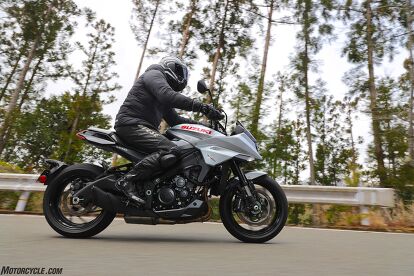
Helmet: [url=https://imp.i104546.net/c/404739/1147743/11256?subId1=VS_motorcycle_Revzilla_2020SuzukiKatanaReview&u=https%3A%2F%2Fwww.revzilla.com%2Fmotorcycle%2Farai-signet-x-shockwave-helmet-2020]Arai Signet X Shockwave Black Frost[/url][/b] $829.95[/p]
- Jacket: Limonita Komatsu Katana! (unobtanium)[/b]
- Leathers:[/b] Dainese CR-S (discontinued)
- Gloves: [url=https://imp.i104546.net/c/404739/1147743/11256?subId1=VS_motorcycle_Revzilla_2020SuzukiKatanaReview&u=https%3A%2F%2Fwww.revzilla.com%2Fsearch%3F_utf8%3D%25E2%259C%2593%26query%3DDainese%2BDruid%2BD1%2BLong]Dainese Druid D1 Long[/url][/b] $160.97 – $229.95
Boots:[/b] [url=https://imp.i104546.net/c/404739/1147743/11256?subId1=VS_motorcycle_Revzilla_2020SuzukiKatanaReview&u=https%3A%2F%2Fwww.revzilla.com%2Fsearch%3F_utf8%3D%25E2%259C%2593%26query%3DDainese%2BTorque%2BD1%2BOut]Dainese Torque D1 Out[/url][/b] $299.90 – $399.95[/p]
- Jacket: Limonita Komatsu Katana! (unobtanium)[/b]
- Leathers:[/b] Dainese CR-S (discontinued)
- Gloves: [url=https://imp.i104546.net/c/404739/1147743/11256?subId1=VS_motorcycle_Revzilla_2020SuzukiKatanaReview&u=https%3A%2F%2Fwww.revzilla.com%2Fsearch%3F_utf8%3D%25E2%259C%2593%26query%3DDainese%2BDruid%2BD1%2BLong]Dainese Druid D1 Long[/url][/b] $160.97 – $229.95
- Boots:[/b] [url=https://imp.i104546.net/c/404739/1147743/11256?subId1=VS_motorcycle_Revzilla_2020SuzukiKatanaReview&u=https%3A%2F%2Fwww.revzilla.com%2Fsearch%3F_utf8%3D%25E2%259C%2593%26query%3DDainese%2BTorque%2BD1%2BOut]Dainese Torque D1 Out[/url][/b]
2020 Suzuki Katana Specifications | |
|---|---|
| Engine | In-line 4 cylinder, liquid-cooled, DOHC |
| Displacement | 999cc |
| Bore x Stroke | 73.4 mm x 59.0 mm |
| Fuel System | Fuel injection |
| Starter | Electric |
| Transmission | 6-speed with back-torque limiting clutch |
| Horsepower | 147 hp at 10000 rpm (claimed) |
| Torque | 79.7 lb-ft at 9500 rpm (claimed) |
| Front Suspension | 43mm KYB fully adjustable inverted forks, 4.7 inches of travel |
| Rear Suspension | Link type shock with adjustable rebound & spring preload, 5.1 inches of travel |
| Front Brakes | Brembo radial-mount monobloc calipers, 310mm dics with ABS |
| Rear Brakes | Nissin single piston caliper with ABS |
| Front Tire | 120/70 ZR17 (58W), tubeless |
| Rear Tire | 190/50 ZR17 (73W), tubeless |
| Rake / Trail | 25° / 3.9 inches |
| Seat Height | 32.5 inches |
| Length | 83.7 inches |
| Width | 32.7 inches |
| Height | 43.7 inches |
| Wheelbase | 57.5 inches |
| Curb Weight | 474 pounds (claimed) |
| Fuel Capacity | 3.2 gallons |
| Colours | Metallic Mystic Silver / Glass Sparkle Black |
We are committed to finding, researching, and recommending the best products. We earn commissions from purchases you make using the retail links in our product reviews. Learn more about how this works.
More by John Burns



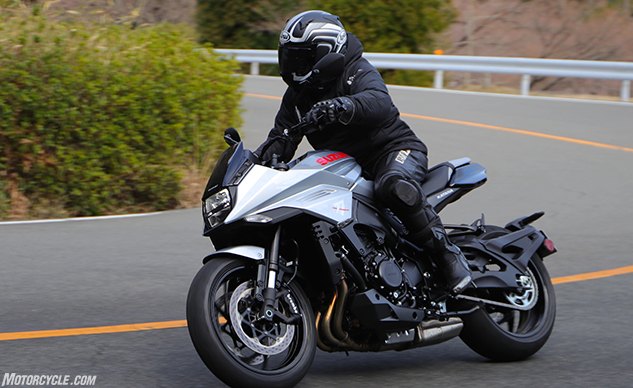





















































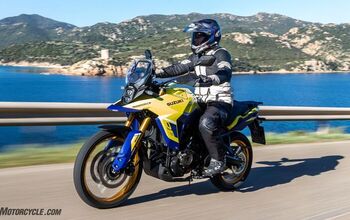
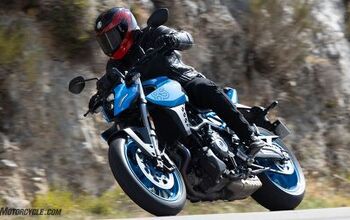
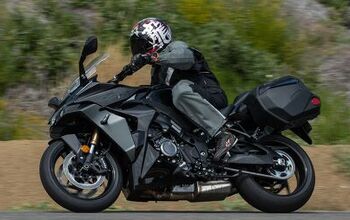











Comments
Join the conversation
Love this bike! And love the direction they're going with the seat. I'd like to see more of a single seat ala Can-Am Ryker. At first I hated what bikes started to do with the back end, starting around the 2000's, but what it's evolving into, I love it. It's like a naked bobber, or street bobber, if there ever was such a thing. I would love to somehow customize my 2017 Ninja 1000 and my 2003 GSX-R 1000 with this look. Not sure where the battery will go, lol.
Why would I buy a GSX-1000S with different plastic and a 3.2 gallon (LOL) tank? You really can't even leave town with the range on this bike.
I mean, if you're going to go after nostalgia, at least be bold about it instead of slapping new plastic on an existing average standard bike. There's absolutely nothing bold about this Katana, because it's a GSX-1000S, and while perfectly capable, and imminently average, there's nothing bold about that bike.